Hyundai Elantra: Engine Control System / Engine Control Module (ECM)
Schematic diagrams
| ECM Terminal And Input/Output signal |
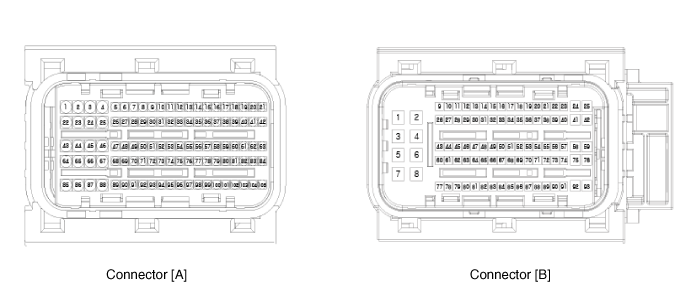
Connector [A]
Pin No
|
Description
|
1
| Fuel Pressure Control Valve (FPCV) [High] control
|
2
| Integrated Thermal Mangement Module (ITM) Motor (+)
|
3
| Integrated Thermal Mangement Module (ITM) Motor (-)
|
4
| -
|
5
| Engine Coolant Temperature Sensor (ECTS) #1 (Ground)
|
6
| -
|
7
| Engine Coolant Temperature Sensor (ECTS) #2 (Ground)
|
8
| -
|
9
| Rail Pressure Sensor (RPS) (Ground)
|
10
| -
|
11
| Manifold Absolute Pressure Sensor (MAPS) (Ground)
|
12
| Electric WGT Control Actuator (EWGA) (Ground)
|
13
| -
|
14
| Oil Pressure & Temperature Sensors (OPTS) (Ground)
|
15
| -
|
16
| -
|
17
| A/C Pressure Transducer (APT) (Ground)
|
18
| Sensor Power (+5V) (Camshaft Position Sensor (CMPS) [Bank 1 / Intake, Exhaust])
|
19
| Sensor Power (+5V) (MAPS, CKPS)
|
20
| Sensor Power (+5V) (OPS, ETC, RPS)
|
21
| Sensor Ground (Throttle Position Sensor (TPS))
|
22
| -
|
23
| -
|
24
| Sensor Shield (Knock Sensor (KS))
|
25
| -
|
26
| Ignition Coil (Cylider #3) Control
|
27
| -
|
28
| -
|
29
| -
|
30
| -
|
31
| -
|
32
| -
|
33
| -
|
34
| -
|
35
| Integrated Thermal Mangement Module (ITM) Motor (Ground)
|
36
| -
|
37
| Camshaft Position Sensor (CMPS) [Bank 1 / Intake] Signal
|
38
| -
|
39
| Electric WGT Control Actuator (EWGA) Signal
|
40
| Sensor Power (+5V) (EWGA)
|
41
| Sensor Power (+5V) (APS #1)
|
42
| Sensor Power (+5V) (APT)
|
43
| Injector (Cylinder #3) [+] Control
|
44
| Injector (Cylinder #2) [+] Control
|
45
| -
|
46
| -
|
47
| CCP-CAN (High)
|
48
| Ignition Coil (Cylider #1) Control
|
49
| -
|
50
| -
|
51
| -
|
52
| -
|
53
| -
|
54
| -
|
55
| -
|
56
| -
|
57
| -
|
58
| -
|
59
| -
|
60
| Camshaft Position Sensor (CMPS) [Bank 1 / Exhaust] (Ground)
|
61
| -
|
62
| -
|
63
| Engine RPM Output
|
64
| Injector (Cylinder #1) [+] Control
|
65
| Injector (Cylinder #4) [+] Control
|
66
| Injector (Cylinder #3) [-] Control
|
67
| Injector (Cylinder #4) [-] Control
|
68
| Ignition Coil (Cylider #2) Control
|
69
| CCP-CAN (Low)
|
70
| Camshaft Position Sensor (CMPS) [Bank 1 / Exhaust] Signal
|
71
| Crankshaft Position Sensor (CKPS) (Ground)
|
72
| Ignition Lock Switch Control
|
73
| Oil Pressure Sensor (OPS) Signal
|
74
| Intake Air Temperature Sensor (IATS) Signal
|
75
| Engine Coolant Temperature Sensor (ECTS) #1 Signal
|
76
| Engine Coolant Temperature Sensor (ECTS) #2 Signal
|
77
| -
|
78
| -
|
79
| Throttle Position Sensor (TPS) 2 Signal
|
80
| Rail Pressure Sensor (RPS) Signal
|
81
| -
|
82
| Integrated Thermal Mangement Module (ITM) Motor Signal
|
83
| -
|
84
| A/C Pressure Transducer (APT) Signal
|
85
| -
|
86
| Injector (Cylinder #2) [-] Control
|
87
| Injector (Cylinder #1) [-] Control
|
88
| Fuel Pressure Control Valve (FPCV) [Low] control
|
89
| -
|
90
| Ignition Coil (Cylider #4) Control
|
91
| Crankshaft Position Sensor (CKPS) Signal
|
92
| Integrated Body Control Unit (IBU) External Wake-Up Signal
|
93
| Heated Oxygen Sensor (HO2S) [Bank 1 / Sensor 2] (Ground)
|
94
| -
|
95
| Heated Oxygen Sensor (HO2S) [Bank 1 / Sensor 1] Signal
|
96
| -
|
97
| Oil Temperature Sensor (OTS) Signal
|
98
| Throttle Position Sensor (TPS) 1 Signal
|
99
| -
|
100
| -
|
101
| Manifold Absolute Pressure Sensor (MAPS) Signal
|
102
| Camshaft Position Sensor (CMPS) [Bank 1 / Intake] (Ground)
|
103
| -
|
104
| Knock Sensor (KS) Signal
|
105
| Knock Sensor (KS) (Ground)
|
Connector [B]
Pin No
|
Description
|
1
| Chassis Ground
|
2
| Chassis Ground
|
3
| Battery power (B+) (Battery)
|
4
| Chassis Ground
|
5
| Battery power (B+) (Main Relay)
|
6
| Battery power (B+) (Main Relay)
|
7
| -
|
8
| -
|
9
| Sensor Power (+5V) (ITM Motor)
|
10
| Sensor Power (+5V) (APS #2)
|
11
| Boost Pressure Sensor (BPS) Signal Input
|
12
| Accelerator Position Sensor (APS #2) (Ground)
|
13
| Accelerator Position Sensor (APS #1) (Ground)
|
14
| -
|
15
| -
|
16
| Boost Pressure Sensor (BPS) (Ground)
|
17
| Fuel Level Sender (FLS) Signal
|
18
| Accelerator Position Sensor (APS #2) Signal
|
19
| -
|
20
| -
|
21
| -
|
22
| Rail Pressure Sensor (RPS) Control
|
23
| Cooling Fan Relay [PMW] Control
|
24
| EWGA DC Motor Control (+)
|
25
| EWGA DC Motor Control (-)
|
26
| Ignition Switch Signal Input
|
27
| Sensor Power (+5V) (BPS)
|
28
| -
|
29
| -
|
30
| Brake [Test] Switch Signal Input
|
31
| Brake [Light] Switch Signal Input
|
32
| Accelerator Position Sensor (APS #1) Signal
|
33
| -
|
34
| -
|
35
| Engine Start Switch Signal Input
|
36
| -
|
37
| Fuel Pump Relay Control [Without Smart Key] Control
|
38
| -
|
39
| -
|
40
| Variable Oil Pump Valve Control
|
41
| ETC Motor [+] Control
|
42
| ETC Motor [-] Control
|
43
| -
|
44
| -
|
45
| P-CAN (Low)
|
46
| -
|
47
| -
|
48
| Clutch Switch Control
|
49
| Wiper Switch Input
|
50
| -
|
51
| Start Relay (Low) Control
|
52
| -
|
53
| -
|
54
| Electric load Signal Input [Defrost]
|
55
| -
|
56
| -
|
57
| -
|
58
| -
|
59
| -
|
60
| Battery power (B+) (Battery)
|
61
| LIN Communication Signal Input
|
62
| P-CAN (High)
|
63
| -
|
64
| Heated Oxygen Sensor (HO2S) [Bank 1 / Sensor 1] VS-/IP- (Virtual Ground)
|
65
| Heated Oxygen Sensor (HO2S) [Bank 1 / Sensor 1] Rc/Rp (Pumping Cell Current)
|
66
| Heated Oxygen Sensor (HO2S) [Bank 1 / Sensor 1] Rc (Adjust Resistance)
|
67
| Heated Oxygen Sensor (HO2S) [Bank 1 / Sensor 1] VS+ (NERNST Cell Current)
|
68
| -
|
69
| -
|
70
| -
|
71
| Start Relay (High) Control
|
72
| -
|
73
| -
|
74
| Engine Control Relay Control
|
75
| Heated Oxygen Sensor (HO2S) [Bank 1 / Sensor 1] Heater Control
|
76
| Heated Oxygen Sensor (HO2S) [Bank 1 / Sensor 2] Heater Control
|
77
| Vehicle Speed Input (IBU, VDC Moduel)
|
78
| CCP-CAN (High)
|
79
| CCP-CAN (Low)
|
80
| -
|
81
| -
|
82
| -
|
83
| Purge Control Solenoid Valve (PCSV) Control
|
84
| Fuel Pump Relay Control [With Smart Key] Control
|
85
| -
|
86
| -
|
87
| Integrated Body Control Unit (IBU) (IMMO, Data Line)
|
88
| -
|
89
| -
|
90
| -
|
91
| -
|
92
| Variable Force Solenoid (VFS) [Bank 1 / Intake] Control
|
93
| Variable Force Solenoid (VFS) [Bank 1 / Exhaust] Control
|
Repair procedures
| 1. | Turn ignition switch OFF and disconnect the battery negative (-) terminal. |
| 2. | Disconnect the ECM Connector (A). 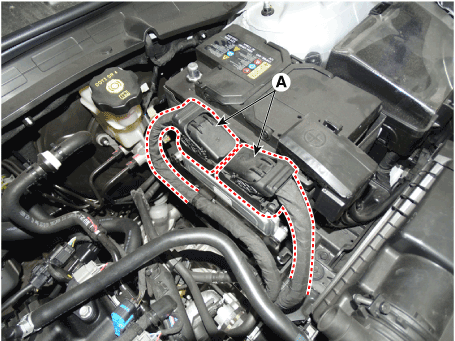
|
| 3. | Remove the ECM (B) after releasing the fixing hooks (A). 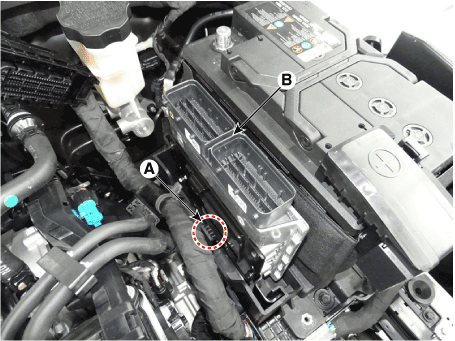
|
| 4. | Remove the ECM (B) after loosening the mounting bolts (A). ECM Mounting bolt : 6.7 - 8.3 N.m (0.7 - 0.85 kgf.m, 5.1 - 6.1 lb-ft) |
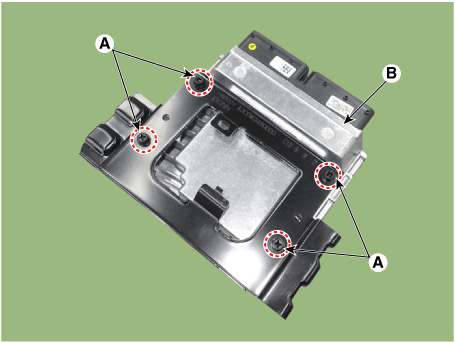
|
| 1. | Install in the reverse order of removal. |
| 1. | TEST ECM GROUND CIRCUIT : Measure resistance between ECM and chassis ground using the backside of ECM harness connector as ECM side check point. If the problem is found, repair it. |
| 2. | TEST ECM CONNECTOR : Disconnect the ECM connector and visually check the ground terminals on ECM side and harness side for bent pins or poor contact pressure. If the problem is found, repair it. |
| 3. | If problem is not found in Step 1 and 2, the ECM could be faulty. If so, make sure there were no DTC's before swapping the ECM with a new one, and then check the vehicle again. If DTC's were found, examine this first before swapping ECM. |
| 4. | RE-TEST THE ORIGINAL ECM : Install the original ECM (may be broken) into a known-good vehicle and check the vehicle. If the problem occurs again, replace the original ECM with a new one. If problem does not occur, this is intermittent problem. (Refer to "Intermittent Problem Inspection Procedure" in Basic Inspection Procedure) |
ECM neutralization procedure (With immobilizer)
| •
| When replacing the ECM, the vehicle equipped with the immobilizer must be performed procedure as below. |
[In the case of installing used ECM] | 1) | Perform "ECM Neutral mode" procedure with diagnostic tool. (Refer to Body Electrical System - "Immobilizer System") |
| 2) | After finishing "ECM Neutral mode", perform "Keyteaching" procedure with diagnostic tool. (Refer to Body Electrical System - "Immobilizer System") |
[In the case of installing new ECM] | –
| Perform "Key teaching" procedure with diagnostic tool. (Refer to Body Electrical System - "Immobilizer System") |
|
ECM Neutralization procedure (With smart key)
| •
| When replacing the ECM, the vehicle equipped with the smart key system (Button start) must be performed procedure as below. |
[In the case of installing used ECM] | 1) | Perform "ECM Neutral mode" procedure with diagnostic tool. (Refer to Body Electrical System - "Immobilizer System") |
| 2) | After finishing "ECM Neutral mode", insert the key (or press the start button) and turn it to the IGN ON and OFF position. Then the ECM learns the smart key information automatically. |
[In the case of installing new ECM] | –
| Insert the key (or press the start button) and turn it to the IGN ON and OFF position. Then the ECM learns the smart key information automatically. |
|
ETC Module Learning Process
After replacing or re-installing the ECM, if you do not perform the ETC module learning procedure, the ETC module learning procedure must be performed since shift shock or failure code may be displayed.
(Refer to Engine Control System - "ETC System")
VIN Programming Procedure
VIN (Vehicle Identification Number) is a number that has the vehicle's information (Maker, Vehicle Type, Vehicle Line/Series, Body Type, Engine Type, Transmission Type, Model Year, Plant Location and so forth. For more information, please refer to the group "GI" in this SERVICE MANUAL). When replacing an ECM, the VIN must be programmed in the ECM. If there is no VIN in ECM memory, the fault code (DTC P0630) is set.
| •
| The programmed VIN cannot be changed. When writing the VIN, confirm the VIN carefully. |
|
| 1. | Turn the ignition switch OFF. |
| 2. | Connect the diagnostic tool to Data Link Connector (DLC). |
| 3. | Turn the igntion switch ON. |
| 4. | Select "Vehicle, Model Year, Engine, System". |
| 5. | Select "Vehicle S/W Management". |
| 6. | Select "Write VIN". 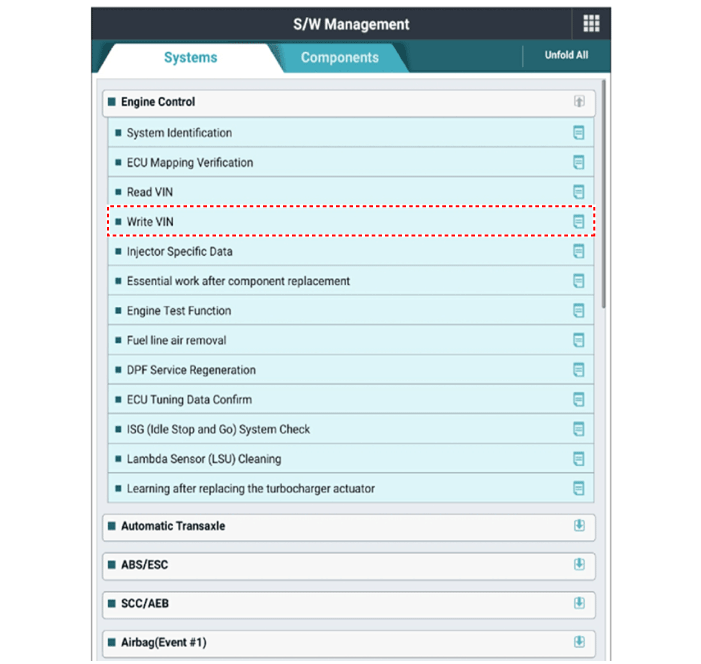
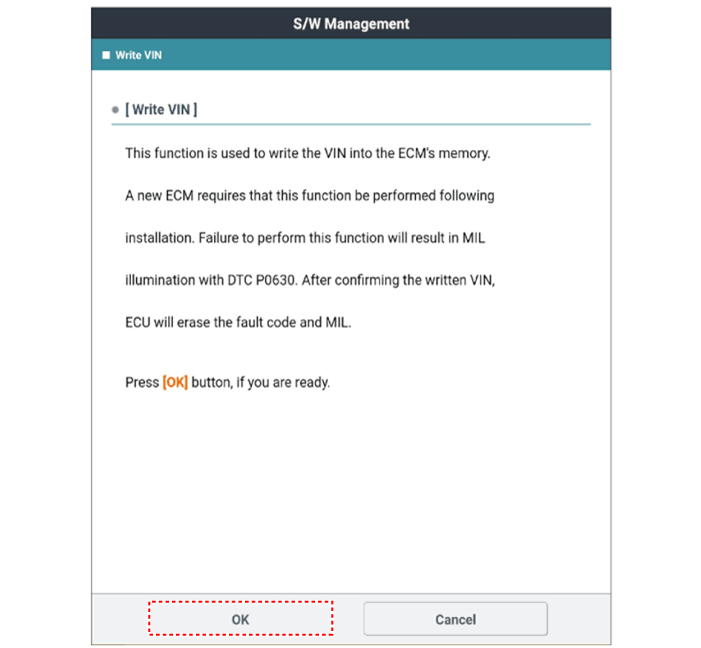
|
Components Location1. Engine Control Module (ECM)2. Manifold Absolute Pressure Sensor (MAPS)3. Intake Air Temperature Sensor (IATS)4. Boost Pressure Sensor (BPS)5...
Description and operation
DescriptionBoost pressure sensor (BPS) is installed on top of intercooler output pipe to measures the pressure of supercharged air in the turbocharger...
Other information:
Check your tires, including the spare tire,
once a month or more.
How to check
Use a good quality tire pressure gauge
to check tire pressure. You can not tell
if your tires are properly inflated simply
by looking at them. Radial tires may look
properly inflated when they are underinflated...
Adjustment1.After loosening the hinge (A) mounting bolt, adjust the hood (B) by moving it up and down or from side to side and tighten the bolt.2.Adjust the hood height by moving the hood overslam bumpers (C) up and down.3.After loosening the hood latch (D) mounting bolts, adjust the latch by moving it up and down or from side to side...

 Components and components location
Components and components location Boost Pressure Sensor (BPS)
Boost Pressure Sensor (BPS)






.png)